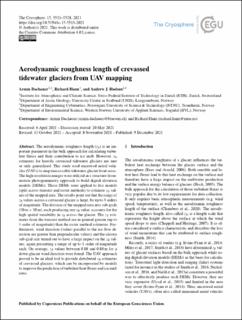| dc.contributor.author | Dachauer, Armin | |
| dc.contributor.author | Hann, Richard | |
| dc.contributor.author | Hodson, Andrew | |
| dc.date.accessioned | 2022-09-07T07:27:01Z | |
| dc.date.available | 2022-09-07T07:27:01Z | |
| dc.date.created | 2021-12-09T10:32:23Z | |
| dc.date.issued | 2021 | |
| dc.identifier.citation | The Cryosphere. 2021, 15 (12), 5513-5528. | en_US |
| dc.identifier.issn | 1994-0416 | |
| dc.identifier.uri | https://hdl.handle.net/11250/3016161 | |
| dc.description.abstract | The aerodynamic roughness length (z0) is an important parameter in the bulk approach for calculating turbulent fluxes and their contribution to ice melt. However, z0 estimates for heavily crevassed tidewater glaciers are rare or only generalised. This study used uncrewed aerial vehicles (UAVs) to map inaccessible tidewater glacier front areas. The high-resolution images were utilised in a structure-from-motion photogrammetry approach to build digital elevation models (DEMs). These DEMs were applied to five models (split across transect and raster methods) to estimate z0 values of the mapped area. The results point out that the range of z0 values across a crevassed glacier is large, by up to 3 orders of magnitude. The division of the mapped area into sub-grids (50 m × 50 m), each producing one z0 value, accounts for the high spatial variability in z0 across the glacier. The z0 estimates from the transect method are in general greater (up to 1 order of magnitude) than the raster method estimates. Furthermore, wind direction (values parallel to the ice flow direction are greater than perpendicular values) and the chosen sub-grid size turned out to have a large impact on the z0 values, again presenting a range of up to 1 order of magnitude each. On average, z0 values between 0.08 and 0.88 m for a down-glacier wind direction were found. The UAV approach proved to be an ideal tool to provide distributed z0 estimates of crevassed glaciers, which can be incorporated by models to improve the prediction of turbulent heat fluxes and ice melt rates. | en_US |
| dc.language.iso | eng | en_US |
| dc.publisher | European Geosciences Union | en_US |
| dc.rights | Navngivelse 4.0 Internasjonal | * |
| dc.rights.uri | http://creativecommons.org/licenses/by/4.0/deed.no | * |
| dc.title | Aerodynamic roughness length of crevassed tidewater glaciers from UAV mapping | en_US |
| dc.type | Peer reviewed | en_US |
| dc.type | Journal article | en_US |
| dc.description.version | publishedVersion | en_US |
| dc.source.pagenumber | 5513-5528 | en_US |
| dc.source.volume | 15 | en_US |
| dc.source.journal | The Cryosphere | en_US |
| dc.source.issue | 12 | en_US |
| dc.identifier.doi | 10.5194/tc-15-5513-2021 | |
| dc.identifier.cristin | 1966558 | |
| dc.relation.project | Norges forskningsråd: 223254 | en_US |
| dc.relation.project | Norges forskningsråd: 294764 | en_US |
| dc.relation.project | Norges forskningsråd: 296355 | en_US |
| cristin.ispublished | true | |
| cristin.fulltext | original | |
| cristin.qualitycode | 2 | |

